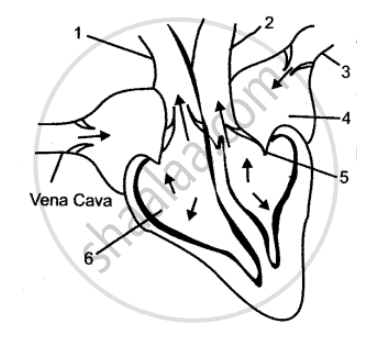Advertisements
Advertisements
प्रश्न
The figure below represents the internal structure of a mammalian heart and the associated blood vessels.
(i) (a) Name each of the structures labeled 1, 2, 3, 4, 5, 6, 7 and 8.
(b) State the function of each of the structures 5, 6, 7, and 8.
(ii) (a) State the function of the heart as an entire organ.
(b) Why are the walls of the left ventricle more muscular than the right?
उत्तर
(i) (a)
1. Right auricle,
2. Left ventricle,
3. Pulmonary artery,
4. Pulmonary vein,
5. Inferior vena cava,
6. Aorta,
7. Pulmonary semilunar valve,
8. Tricuspid valve.
(b)
5 — carry deoxygenated blood from the body parts to the right auricle of the heart.
6 — distributes blood all over the body.
7 — prevents the backflow of the blood into the ventricles.
8 — prevents the reverse flow of the blood from the right ventricle into the right auricle,
(ii) (a) The heart makes the blood to circulate all over the body.
(b) The walls of the left ventricle are more muscular because they have to pump blood to a larger distance than the right so that walls have to withstand high pressure.
APPEARS IN
संबंधित प्रश्न
What are the components of the transport system in human beings? What are the functions of these components?
Select the odd one in the following:
Artery, Vein, Capillary, Nerve.
Choose the correct answer:
In mammals the opening of post caval in the right auricle is guarded by _________
The diagram given below represents the human heart in one phase of its activity. Study the same and then answer the question that follow:
Which part of the heart is contracting in this phase? Give a reason to support your answer.

The diagram given below represents the human heart in one phase of its activity. Study the same and then answer the question that follow:
What type of blood flows through the parts marked '1' and '2'?

Give scientific reason.
Human heart is called as myogenic and autorhythmic.
The blood does not flow back into the ______ when mitral valve closes.
What is the duration of joint diastole?
Complete the analogy.
The contraction of heart muscles: Systole:: Relaxation of heart muscles: ______.
Write the exact location of the following:
Heart
